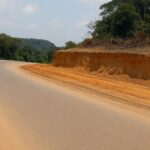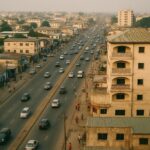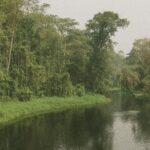Illegal buildings threaten Djiri water plant
The green banks of the Djiri River normally hum with pumps and filters rather than concrete mixers. Yet this week reporters invited by La Congolaise des Eaux, LCDE, found new foundations rising a few metres from critical intake pipes.
Engineers warn that if the construction continues, the capital’s main drinking-water plant could lose the sterile buffer zone that prevents pollution and accidental damage. In a city already coping with rising demand and seasonal floods, any disruption would ripple quickly through households and hospitals.
Djiri supplies 70 percent of city taps
Djiri supplies roughly seventy percent of Brazzaville’s taps, according to the LCDE’s operations director Guy Serge Ndinga Ossondjo. “When you interfere with this perimeter, you interfere with the health of more than two million people,” he told the assembled cameras with visible frustration.
How the land dispute started
The episode began in late September, when LCDE guards noticed surveyors placing boundary pegs on land classified as state property since 1982. Within days, trucks brought gravel, and workers started digging trenches for what neighbours describe as future residential lots.
LCDE filed a complaint at the Brazzaville court and requested support from the National Gendarmerie. An initial patrol halted work, but briefly. By the time journalists visited on 17 October, masonry had resumed behind improvised bamboo screens.
Those claiming ownership say their families were unfairly expropriated during the plant’s expansion in the 1980s. One elder, refusing to give his name, argued that compensation payments promised decades ago never arrived, leaving descendants with little choice but to reclaim ancestral plots.
Why the safety buffer is crucial
Official cadastral maps, however, label the zone as a public utility easement dedicated to water security. Environmental expert Thérèse Mavoungou notes that such buffers are standard around intakes worldwide because even a single fuel spill or latrine pit can force expensive shutdowns.
The Ministry of Energy and Hydraulics told local radio the land remains state property. An adviser announced a task force with the Prefecture to “seal the critical belt and negotiate civil solutions with legitimate heirs.”
For now, LCDE engineers rely on real-time sensors to detect any sudden change in turbidity or chemical balance. “If the readings spike, we may have to shut the valves immediately,” explains plant manager Irénée Malonga. Such an emergency stop would leave many districts dry.
Economic and social stakes of an outage
Brazzaville consumes close to 200,000 cubic metres of treated water a day, a figure that rises during the long dry season. Alternative sources exist, including the Djoué site, but they cannot cover the shortfall without extended rationing and tanker deliveries.
Economists stress hidden costs of brief interruptions. Pump breakdowns, hospital sterilisation delays and lost classroom hours add up quickly. The Chamber of Commerce warns a 48-hour citywide outage could wipe out over 1.5 billion CFA francs in productivity.
Residents living downstream of the plant voice fears that new latrines and septic pits could leach into the riverbed. “We fetch water for laundry directly from the Djiri when taps run slow,” says market vendor Clarisse Bemba. “Dirty runoff would hit us first.”
Mediation, reform and community watch
Civil-society group Les Amis du Fleuve plans an awareness caravan explaining the safety corridor. Coordinator Emery Samba hopes dialogue will ease tension. “Protecting the plant also protects children’s health and property values,” he says.
Legal specialists interviewed by Télé Congo say the case will test recent reforms aimed at speeding up land-registry disputes. A 2022 decree created special chambers within the Tribunal de Grande Instance to handle public-utility sites, but few precedents have reached a final ruling.
While the courts deliberate, LCDE urges residents to report suspicious activity near pipes or reservoirs. A hotline number has been circulated on social media, and the company promises rapid joint interventions with local police. The measure mirrors community-watch tactics already used for electricity pylons.
Public-health officials commend the vigilance. Doctor Valère Mbemba of the University Hospital reminds that Congo avoided cholera outbreaks that struck neighbouring towns last year partly because urban water remained chlorinated. “We cannot gamble with that record,” he insists.
The Djiri dispute feeds wider debates about Brazzaville’s rapid growth. The capital has doubled in surface since the early 2000s, often without full zoning plans. Analysts argue that clearer public-infrastructure boundaries are essential to sustain the city’s economic momentum.
Protecting Djiri protects Brazzaville
For families of former landholders, however, unresolved compensation amplifies feelings of exclusion. Sociologist Mireille Okemba suggests setting up an independent mediation panel. “Acknowledging past grievances while enforcing today’s sanitary rules could turn a conflict into a cooperative model,” she says.
Until durable solutions emerge, the pumps keep turning and eyes stay trained on the safety perimeter. LCDE’s Ndinga Ossondjo offers a steady message: “Protecting Djiri is protecting Brazzaville.” For residents filling kettles each dawn, the plea resonates every time a faucet runs clear.






















